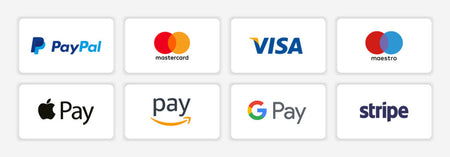Descrição
Limit Switch Course: Symbols and Operation
If you are interested in learning about limit switches and their symbols, you have come to the right place! In this blog, we will explore the main elements of this course and how they are represented.
What are limit switches?
Limit switches are devices used to detect the position of an object or equipment at a given time. They are widely used in industrial automation and are essential to ensure the proper functioning of machines and processes.
Symbols of limit switches
The symbolism of limit switches is essential to understand how they work and correctly interpret their characteristics. Let's take a look at some of the main symbols used:
- NC: Normally Closed - indicates that the switch contact is closed when there is no actuation;
- NO: Normally Open - indicates that the switch contact is open when there is no actuation;
- COM: Common - represents the common contact of the switch;
- + - indicates the switch power supply;
- - - indicates the switch return;
Operation of limit switches
Limit switches have an internal mechanism that is activated when there is a change in the position of the monitored object or equipment. This activation can be done by means of a mechanical contact or by magnetic or inductive sensors.
When the switch is activated, there is a change in the state of the contacts, which can be from NC (Normally Closed) to NO (Normally Open) or vice versa. This change of state is used to send an electrical signal to a controller or automation device, which will interpret this information and take the necessary actions.
| Symbology | Description |
|---|---|
| NC | Normally Closed |
| NO | Normally Open |
| COM | Common |
It is important to emphasize that limit switches can be used in different applications, from simple to complex systems, depending on the needs of the industrial process.
We hope this blog has helped you understand a little more about the limit switch course and its symbology. If you are interested in deepening your knowledge in this area, be sure to sign up for our course and learn everything about the operation and application of limit switches.
What is the limit switch symbology
Limit switches are devices used in various equipment and machines to indicate the end of a mechanical movement. They are responsible for sending an electrical signal when a certain reference point is reached, allowing the machine to perform specific actions.
Symbols used to represent the limit switch
In the symbology used to represent the limit switch, it is common to find the following elements:
- Normally open contact (NO): Represented by a circle with an arrow coming out of it.
- Normally closed contact (NC): Represented by a circle with an arrow entering it.
- Actuator: Represented by a straight line with an arrow at the end.
These symbols are used in electrical diagrams and circuit diagrams to indicate the presence of the limit switch and its specific function.
Applications of the limit switch course
The limit switch is widely used in various sectors of industry, such as industrial automation, robotics, CNC machines, among others. others. It can be applied to different types of equipment, such as presses, conveyors, elevators, automatic doors, among others.
Its main objective is to ensure the safety and correct operation of this equipment, avoiding accidents and material damage. When the limit switch is activated, it can interrupt the operation of the machine, trigger alarms or perform other safety actions.
SERP Features related to limit switch
When researching limit switch, it is possible to find several SERP features related to the subject. Some of them are:
- Sitelinks: Additional links displayed below the main result, which direct to specific website pages related to the limit switch.
- Reviews: User reviews and opinions on different models and brands of limit switches.
- People also ask: Frequently asked questions by users about the limit switch, along with their answers.
- Knowledge panel: Information panel that appears on the right side of the results page, providing relevant data about the limit switch.
- FAQ: Frequently asked questions about the limit switch, answered clearly and objectively.
- Top stories: Recent news related to the limit switch and its applications.
- Recipes: Recipes or step-by-step instructions for installing and configuring the limit switch.
- Find results on: Resources that allow you to find additional results about the limit switch on other websites or platforms.
- See results about: Option to view results related to the limit switch in different categories or segments.
- Related searches: Search terms related to the limit switch that may be useful for deepening knowledge on the subject.
These SERP features provide users with a variety of additional information and resources about the limit switch, making it easier to search for relevant and useful content.
In summary, the limit switch is an important device in the industry, used to indicate the end of a mechanical movement. Its symbology is represented by different elements, and its application covers several sectors. When researching the subject, it is possible to find several related SERP features, which provide additional information and useful resources for users.
What is a limit switch: symbology and functionality
Limit switches are devices used in various sectors of industry to monitor and control the movement of machines and equipment. They play a fundamental role in the safety and automation of processes, ensuring proper functioning and preventing accidents.
Symbolism of limit switches
The symbology of limit switches is standardized and used to visually represent the different positions and states in which the device can be found. These symbols are widely recognized and facilitate the understanding and interpretation of the information transmitted by the switch.
The main symbols used are:
- NO (Normally Open): represents the position in which the switch contact is open when there is no actuation.
- NC (Normally Closed): represents the position in which the switch contact is closed when there is no actuation.
- COM (Common): represents the common contact of the switch, which is connected to the electrical circuit.
Functionality of limit switches
Limit switches consist of a drive mechanism and a set of of electrical contacts. When the mechanism is activated, the contacts change state, opening or closing the electrical circuit.
These switches are widely used to detect the position of moving objects or components, such as doors, valves, conveyor belts, among others. When the object reaches a certain position, the switch is activated, sending an electrical signal to the control system.
In addition, limit switches can also be used as safety devices, interrupting the operation of machines and equipment in emergency situations. When a failure or risky situation occurs, activating the switch can turn off the system, preventing accidents and damage.
Applications of limit switches
Limit switches are widely used in various industrial sectors, such as the automotive, steel, food, among others. Their applications are varied and essential to ensure the safety and efficiency of processes.
Some of the main applications are:
- Detection of door and window position;
- Movement control of conveyors and tracks;
- Monitoring of valve and actuator position;
- Safety in machines and equipment;
- Access control in security systems;
- Industrial automation.
Conclusion
Limit switches play a fundamental role in industry, ensuring the safety and efficiency of processes. Through standardized symbology and precise functionality, these devices are essential for monitoring and controlling movements in machines and equipment.
- Sitelinks
- Reviews
- People also ask
- Knowledge panel
- FAQ
- Top stories
- Recipes
- Find results on
- See results about
- Related searches
What is the best limit switch symbology
Limit switches are devices used in various sectors of industry to detect the position of an object or equipment. They are widely used in industrial machinery, automation, robotics and other systems that require motion control.
Symbolism of limit switches
Limit switches have specific symbols to represent their characteristics and functionalities. This symbolism is important to facilitate the identification and understanding of the devices by professionals who work with them.
The main elements of the limit switch symbology are:
- NC: Normally Closed
- NO: Normally Open
- COM: Common
- + Contact
- - Contact
These elements are combined to represent the different configurations and types of limit switches. For example, a limit switch with normally closed and common contact is represented as NC+COM.
What is the best limit switch?
The choice of the best limit switch depends on the needs and characteristics of the system in which it will be used. Some factors to be considered in the choice are:
- Application: It is important to consider the environment in which the limit switch will be used. Some models are more suitable for environments with high temperatures, humidity or the presence of corrosive substances.
- Load capacity: It is necessary to check the load capacity of the limit switch, that is, the amount of electrical current it supports. This information is important to ensure the correct operation of the device.
- Type of actuation: There are different types of actuation for limit switches, such as lever, roller, rod, among others. The choice of actuation type depends on the object or equipment that will be detected.
- Reliability: It is essential to choose a quality limit switch that is reliable and durable. This prevents system failures and reduces the need for maintenance.
It is recommended to consult an expert in the field to help you choose the best limit switch for each specific application.
Related SERP Features
Below, we present some SERP Features related to the topic:
- Sitelinks: Additional links displayed in search results that direct to specific pages on the website.
- Reviews: User reviews and opinions about limit switches.
- People also ask: Frequently asked questions related to the topic.
- Knowledge panel: Knowledge panel that displays relevant information about limit switches.
- FAQ: Frequently asked questions about limit switches.
- Top stories: Recent news related to the topic.
- Recipes: Recipes related to the topic.
- Find results on: Search option related to limit switches.
- See results about: Search option related to information about limit switches.
- Related searches: Searches related to the topic.
We hope this article has helped you understand a little more about the symbology of limit switches and how to choose the best model for each application. Always remember to seek additional information and consult experts to ensure the safety and efficiency of the system.
What is the limit switch symbology for?
The limit switch is a device used in various industrial equipment and machines to indicate the end of a movement or position. It is responsible for sending an electrical signal when a certain condition is reached, such as the closing of a door, the movement of a piston or the position of an axis.
Symbols used to represent the limit switch
In industrial symbology, the limit switch is represented by a specific symbol, which indicates its function and characteristics. The most common symbols are:
- Lever limit switch: represented by a rectangle with a lever coming out of one side;
- Roller limit switch: represented by a rectangle with a roller coming out of one side;
- Rod limit switch: represented by a rectangle with a rod coming out of one side;
- Pulley limit switch: represented by a rectangle with a pulley coming out of one side;
- Spring limit switch: represented by a rectangle with a spring coming out of one side.
Limit switch applications
Limit switches are widely used in industry to ensure the safety and correct operation of machines and equipment. Some of its main applications are:
- Control of automatic doors and gates;
- Control of piston and cylinder movements hydraulics;
- Conveyor belt positioning control;
- Industrial robot movement control;
- CNC machine movement control;
- Elevator movement control;
- Crane movement control;
- Overhead crane movement control;
- Packaging machine movement control;
- Welding machine movement control.
The limit switch is essential to ensure operator safety and prevent damage to equipment. It allows machines to stop automatically when a certain position is reached, preventing accidents and losses.
SERP features related to limit switch
When searching for limit switch, it is possible to find several SERP features related to the subject. Some of them are:
- Sitelinks: additional links displayed below the main result, which direct to specific pages on the site;
- Reviews: user reviews and opinions about the end stop switch;
- People also ask: frequently asked questions related to the end stop switch, with their answers;
- Knowledge panel: information panel about the end stop switch, displayed on the right side of the results page;
- FAQ: frequently asked questions section about the end stop switch;
- Top stories: recent news related to the end stop switch;
- Recipes: recipes related to the end stop switch (in this case, not applicable);
- Find results on: suggestions for other terms related to limit switch;
- See results about: links to results related to limit switch;
- Related searches: terms related to limit switch searched by other users.
These SERP features can provide additional and useful information about the limit switch, helping users to better understand its operation, applications and characteristics.
In summary, the limit switch is an essential device in industry, used to indicate the end of a movement or position. Its specific symbology facilitates its identification in industrial projects and diagrams. In addition, SERP features related to limit switches can provide additional and relevant information for those seeking more details on the subject.
Who can make limit switch symbols?
The limit switch is a device used in various equipment and systems to indicate the end of a movement or position. It is responsible for sending an electrical signal when a certain limit is reached, playing a fundamental role in the safety and control of machines and processes.
Limit switch symbols
The symbols used to represent the limit switch may vary according to the standard adopted in each country or industry. However, there are some commonly used symbols that can be found in technical manuals and electrical diagrams.
One of the most common symbols to represent the limit switch is a rectangle with an arrow coming out of one of the sides. This arrow indicates the movement or position that the switch is monitoring. Additionally, it is common to find additional symbols to indicate whether the switch is normally open (NO) or normally closed (NC).
Who can install the limit switch?
The installation of the limit switch must be performed by qualified and experienced professionals, who have technical knowledge about the equipment or system in which it will be used. This is a task that requires care and attention, as incorrect installation can compromise the device's operation and even cause accidents.
Engineers, industrial automation technicians and electricians are some of the professionals qualified to install limit switches. They have the necessary knowledge to identify the appropriate location for installation, make the electrical connections correctly and test the device's operation.
It is important to emphasize that the installation of the limit switch must follow the safety standards established by current legislation and applicable technical standards. In addition, it is essential to use personal protective equipment (PPE) during installation, ensuring the safety of the professional responsible for the work.
Related SERP Features
When researching limit switches and their symbols, it is possible to find several SERP Features related to the subject. These SERP Features are additional resources displayed in Google search results, which provide relevant information and facilitate the user's search. Some examples of related SERP Features are:
- Sitelinks: Additional links displayed below the main result, which direct the user to specific pages on the site.
- Reviews: User reviews and opinions about the limit switch and its manufacturers.
- People also ask: Frequently asked questions related to the subject, with answers displayed directly in the search results.
- Knowledge panel: Knowledge panel displayed next to the search results, with additional information about the limit switch.
- FAQ: Frequently asked questions about the limit switch and its applications.
- Top stories: Recent news related to the subject.
- Recipes: Recipes on how to install and configure the limit switch of course.
- Find results on: Additional links to find specific results about the limit switch.
- See results about: Additional links to see results about topics related to the limit switch.
- Related searches: Frequently asked questions about the limit switch.
These SERP Features can be useful for obtaining additional information, clarifying doubts and finding relevant resources about the limit switch and its symbology.
In summary, the limit switch is an important device for the safety and control of equipment and systems. Its symbology may vary, but there are common symbols used to represent it. The installation of the limit switch must be performed by qualified professionals, following safety standards. When researching the subject, it is possible to find several related SERP Features, which provide additional information and facilitate the user's search.
How long does a limit switch last: symbology and functionality
Limit switches are devices widely used in various sectors of industry to monitor and control the movement of machines and equipment. They play a fundamental role in the safety and efficiency of operations, ensuring that movement limits are respected.
The importance of symbology in limit switches
The symbology used in limit switches is essential for a correct interpretation of their functionalities and limitations. Each symbol represents a specific feature of the device, allowing operators and technicians to easily identify its properties.
The main symbols used on limit switches are:
- NO (Normally Open): indicates that the limit switch contact is open rto when there is no actuation;
- NC (Normally Closed): indicates that the limit switch contact is closed when there is no actuation;
- COM (Common): indicates the common connection point between the NO and NC contacts;
- NA (Normally Open): indicates that the limit switch contact is open when there is actuation;
- NC (Normally Closed): indicates that the limit switch contact is closed when there is actuation;
The functionality of limit switches
Limit switches are mechanical devices composed of an actuator and electrical contacts. When the actuator is actuated by a moving object, the electrical contacts are opened or closed, depending on the type of limit switch.
These devices are widely used to detect the position of objects, limit the movement of machines and equipment, and even as safety devices to stop the operation of a machine in case of emergency.
Some examples of limit switch applications are:
- Valve position detection in hydraulic and pneumatic systems;
- Travel limitation in automatic doors;
- Emergency stop in conveyor belts;
- Position control in industrial robots;
- Position monitoring in elevators;
| Type of Limit Switch | Functionality |
|---|---|
| Lever Limit Switch | Actuates when the lever is actuated |
| Roller Limit Switch | Actuates when the roller is pressed |
| Rod Limit Switch | Actuates when the rod is moved |
| Spring Limit Switch | Actuates when the spring is compressed or extended |
It is important to note that the durability of a limit switch may vary according to several factors, such as the quality of the device, the frequency of actuations, environmental conditions and proper maintenance.
To ensure the durability and efficiency of limit switches, it is recommended to:
- Perform periodic inspections to identify wear or damage;
- Clean and lubricate the devices according to the manufacturer's recommendations;
- Replace limit switches when they show failures or signs of excessive wear;
- Use additional protective devices, such as protective covers, when necessary;
Click here to find more information about limit switches and their applications.
Sitelinks: Check out the different types of limit switches available.
Reviews: See what experts say about the durability of limit switches course.
People also ask: How long does a limit switch last? How do I choose the right model for my application?
Knowledge panel: Learn more about the symbols used in limit switches.
FAQ: What are the main precautions when maintaining limit switches?
Top stories: Discover the latest news in limit switch technology.
Recipes: Discover the best practices for increasing the lifespan of limit switches.
Find results on: Find results about the durability of limit switches in different industrial environments.
See results about: See more information about the functionality of limit switches in different applications.
We hope this blog has clarified your doubts about the symbology and functionality of limit switches, as well as their durability. Always remember to follow the manufacturer's recommendations and perform proper maintenance to ensure the proper functioning of these essential devices in the industry.
How much does a limit switch cost: symbology and functionalities
Limit switches are essential devices in several industrial sectors, ensuring the safety and proper functioning of machines and equipment. In this article, we will explore the symbology used to represent these devices, in addition to discussing their functionalities and the costs involved in acquiring them.
Symbolism of limit switches
The symbology used to represent limit switches may vary according to the standards adopted in each country or industry. However, some symbols are widely recognized and used throughout the world.
The most common symbol to represent a limit switch is the following:
⚲
This symbol represents the limit switch actuator, which is responsible for activating the device when a certain condition is reached.
Functionalities of limit switches
Limit switches have several functionalities, the most common being:
- Detecting the position of an object or component;
- Indicating the end of a stroke or movement;
- Triggering an alarm or turning off equipment when a safety condition is violated;
- Controlling the movement of machines and equipment.
These functionalities are essential to ensure the safety of operators and the equipment integrity.
Limit switch costs
Limit switch costs can vary depending on several factors, such as the brand, model, features and quantity purchased. In general, prices can range from R$50 to R$500 per unit.
In addition to the acquisition cost, it is also important to consider the installation and maintenance costs of the limit switches. It is essential to follow the manufacturer's recommendations to ensure the proper functioning and durability of these devices.
Related SERP features
When searching for limit switches, you may find the following SERP features:
- Sitelinks: Additional links displayed below the main result, directing to specific pages on the website related to the subject.
- Reviews: User reviews of different brands and models of limit switches.
- People also ask: Frequently asked questions related to the subject, with answers displayed directly on the results page.
- Knowledge panel: Information panel about limit switches, displaying relevant data and technical details.
- FAQ: Frequently asked questions about limit switches, with answers provided by the website itself.
- Top stories: Recent news related to the topic.
- Recipes: Recipes for dishes that use limit switches (as an example only).
- Find results on: Links to other sites or platforms where you can find more information about limit switches.
- See results about: Links to results related to other aspects of limit switches, such as installation, maintenance, among others.
- Related searches: Search terms related to the topic, suggesting other queries that may be useful.
These SERP features can provide additional information and make it easier to
Estimar frete
Payment & Security

Featured collection





















![Curso de Angular e NodeJS - O Guia da Pilha MEAN [Edição 2023] - IBRATH Instituto Brasileiro de Terapias Holísticas teste011020230809](http://enciclopedia.paginasdabiblia.com/cdn/shop/products/a19556.png?v=1699935448&width=1024)




![Curso de Docker & Kubernetes: O Guia Prático [Edição 2023] - IBRATH Instituto Brasileiro de Terapias Holísticas teste011020230809](http://enciclopedia.paginasdabiblia.com/cdn/shop/products/a19570.png?v=1699935525&width=1024)





















Dúvidas Gerais
Após a confirmação do pagamento, você receberá um e-mail com todas as instruções para acessar seus cursos. O e-mail incluirá um link para a plataforma de ensino, onde você poderá fazer login utilizando suas credenciais cadastradas no momento da compra. Caso seja um curso em formato de arquivo para download, o mesmo estará disponível na área do aluno e poderá ser acessado diretamente pelo link enviado. Se você não receber o e-mail de acesso em até 24 horas, verifique sua caixa de spam ou entre em contato com nossa equipe pelo e-mail suporte@amentil.com.br.
Após a confirmação do pagamento, seu pedido será processado e enviado para o endereço cadastrado. Você receberá um e-mail com os detalhes do envio, incluindo o código de rastreamento para acompanhar a entrega. Trabalhamos com transportadoras confiáveis e os prazos variam de acordo com o método de envio escolhido e sua localização. É importante garantir que o endereço de entrega esteja correto para evitar atrasos. Caso tenha dúvidas ou problemas com a entrega, nossa equipe de suporte está à disposição pelo e-mail suporte@amentil.com.br.
Você pode tirar dúvidas diretamente com nossa equipe de suporte por diversos canais:
- E-mail: Envie sua pergunta para suporte@amentil.com.br, e nossa equipe responderá em até 2 dias úteis.
- Telefone: Ligue para +55 (48) 1234-5678, disponível de segunda a sexta, das 9h às 18h.
- WhatsApp: Envie uma mensagem para +55 (48) 91265-4321 e receba atendimento rápido e prático.
- Formulário de Contato: Preencha o formulário disponível em nosso site na página Contato.
- Redes Sociais: Você também pode enviar suas dúvidas pelo Instagram ou Facebook em @amentil.sa.
Estamos sempre prontos para ajudar!
Reembolso e garantias
O prazo de reembolso pode variar dependendo da forma de pagamento utilizada:
- Cartão de Crédito: O estorno será realizado em até 7 dias úteis após a aprovação do reembolso, mas o crédito poderá aparecer na sua fatura em um prazo de 30 a 60 dias, conforme a política da operadora do cartão.
- Boleto Bancário ou Transferência: O valor será devolvido via depósito em conta bancária em até 7 dias úteis após a aprovação do reembolso.
Você pode solicitar a devolução de produtos físicos seguindo o passo a passo abaixo:
- Entre em contato com nosso suporte:
- Aguarde nossa resposta:
Nossa equipe analisará sua solicitação em até 3 dias úteis e fornecerá as instruções detalhadas para a devolução. - Prepare o produto:
- Envie o produto:
- Reembolso ou troca:
Nosso compromisso é fornecer uma experiência confiável e segura ao acessar nossa enciclopédia online. Garantimos a qualidade dos serviços e funcionalidades oferecidos, seguindo as condições descritas abaixo:
1. Garantia de Acesso
- Disponibilidade: Oferecemos garantia de disponibilidade da enciclopédia online 24 horas por dia, 7 dias por semana, exceto durante períodos programados de manutenção ou por problemas técnicos fora do nosso controle.
- Resolução de Problemas: Em caso de interrupções no serviço, nossa equipe técnica atuará para restaurar o acesso no menor tempo possível.
2. Garantia de Conteúdo
- Precisão e Atualização: Todo o conteúdo disponibilizado é cuidadosamente revisado para garantir precisão e relevância. No entanto, a enciclopédia online é constantemente atualizada, e não podemos garantir a exatidão absoluta em casos de informações sujeitas a mudanças rápidas.
- Correção de Erros: Caso identifique erros ou inconsistências no conteúdo, você pode nos informar pelo e-mail conteudo@amentil.com.br, e faremos a análise e correção, se necessário.
3. Garantia de Segurança
- Proteção de Dados: Utilizamos tecnologias avançadas para proteger suas informações pessoais e garantir que sua navegação na enciclopédia seja segura.
- Privacidade: Todos os dados coletados seguem as diretrizes da nossa Política de Privacidade.
4. Garantia de Reembolso
Para assinaturas da enciclopédia online:
- Direito de Arrependimento: Você pode solicitar o cancelamento e reembolso integral em até 7 dias corridos após a compra, desde que não tenha acessado conteúdos pagos da plataforma.
- Problemas Técnicos: Caso não consiga acessar os conteúdos devido a falhas técnicas imputáveis à plataforma, garantimos suporte prioritário e, se o problema não for resolvido, você pode solicitar reembolso proporcional ao período não utilizado.
5. Limitações
- Conexão à Internet: Não garantimos acesso à enciclopédia em situações de instabilidade ou falhas na conexão de internet do usuário.
- Uso Indevido: O acesso e uso da enciclopédia são pessoais e intransferíveis. O compartilhamento de credenciais pode resultar na suspensão ou cancelamento da assinatura sem reembolso.
6. Contato para Garantias
Caso precise de suporte ou queira exercer algum direito de garantia, entre em contato conosco:
- E-mail: suporte@amentil.com.br
- Telefone: +55 (48) 1234-5678
- Horário de atendimento: Segunda a sexta, das 9h às 18h.



